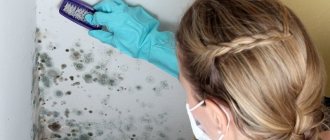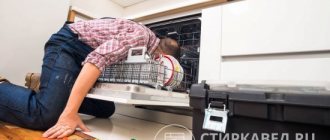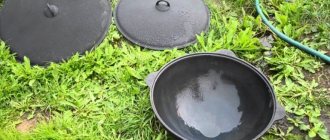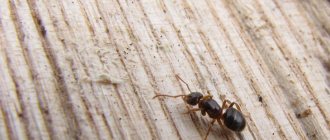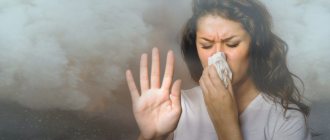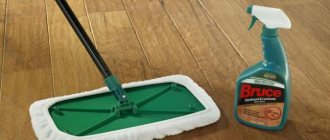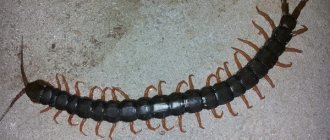Dampness on the walls is a common problem that can appear not only in an apartment, but also in a private house. It must be addressed immediately, because when the walls and corners become damp, not only the wallpaper begins to darken and peel off, but also mold appears.
Dampness on the walls can contribute to the emergence of various diseases, and become a gathering place for insects, mites and fungi . If the wall becomes damp, then you need to act immediately, and this article contains an analysis of the reasons and ways to solve them.
Possible causes of dampness
To understand how to eliminate the appearance of damp spots in corners, it is necessary to determine the causes of the troubles that have arisen. There are quite a few of them, but they are all divided into internal and external. In this case, the entry of moisture into the room can be hidden or obvious.
Among the internal reasons are:
- insufficient heating of the room;
- poor ventilation in the bathroom and kitchen;
- frequent drying of washed laundry inside the apartment;
- insulation from inside the room;
- recently carried out renovations, after which the walls have not yet dried out;
- poorly installed windows and window sills;
- pipe leaks in ceilings, walls or floor screeds;
- formation of condensation on pipes and air ducts due to lack of insulation.
External reasons for a damp corner in the house include:
- freezing of walls as a result of violation of the integrity of thermal insulation;
- moisture ingress due to damage to the roof, breakdown of the drainage system or leaking pipes in the attic;
- high humidity in the basement;
- poor quality foundation waterproofing;
- cracks in the walls and unfilled seams;
- voids at the junction of the balcony slab.
As can be seen from the above reasons, the supply of moisture may depend on the floor, the location of the apartment and the wear and tear of building structures.
Consequences of wet walls
From the first days it may seem that wet walls will go away on their own. For example, after rains they dry out. But if a problem has appeared, it will appear more and more often. And then it will be very difficult to fix it.
As the wet walls continue, bad consequences will appear such as:
- An odor similar to that in the basement will appear.
- The wall materials will begin to deteriorate and peel off. Putty soaked in moisture will come off in whole layers and crumble, because its structure will be damaged. Then you will most likely have to pay for repairs.
- With flooring and wood coverings, the floor may become deformed. Because of this, creaks and cracks, as well as cracks, will appear.
- Furniture standing near such walls will also fall into disrepair.
- The moisture level will rise, which will negatively affect the health of humans and pets. When humidity is more than 60%, the risk of developing respiratory diseases and their exacerbation increases.
- Also allergies. It can also worsen or appear.
- A favorable environment will be created for microbes and bacteria, as well as fungi, including mold. These small living organisms also have a very detrimental effect on health.
- Skin rashes will appear. And if there are wounds or cuts, they will heal worse or even rot.
- It is also worth highlighting such an item as a poor microclimate for children. The fact is that their body is underdeveloped and susceptible to diseases. Thus, the child may suffer greatly.
As you can see, the consequences can be quite dangerous. It's time to talk about how to deal with dampness.
How to get rid of dampness depending on the cause
After determining the reasons why the walls in the house become damp, you can determine ways to eliminate dampness on the walls of the house and begin to eliminate the shortcomings. Sometimes you can do this yourself, but more often you have to turn to specialists, especially if it involves working at heights and roof repairs.
Freezing of walls and insufficient heating. Insulation of the room should be done from the outside, inviting industrial climbers for this. Insulation from the inside will almost certainly lead to a shift of the “dew point” to the middle of the building structure. As a result, the flow of moisture through the wall can only increase.
The specialists you contact for help will be able to perform the necessary thermal calculations and determine the thickness of the thermal insulation layer and the efficiency of the batteries. If the heating system operates unsatisfactorily, it can be recommended to increase the heat transfer area of the heating devices without abandoning the external insulation of the walls.
Ineffective ventilation. The absence of a hood with new sealed windows can lead to condensation and moisture settling in the walls. In this case, it is recommended to ventilate the room through slightly open windows. Another effective way would be to install a low-noise fan in one of the exhaust ducts. Electricity consumption in this case will be minimal, and the effect will be noticeable.
Roof leak. If you live on the top floor, start looking for moisture ingress by inspecting the attic or flat roof. A roof leak is often the cause of dampness in an apartment. It is clear that in this case only urgent roof repairs can help. And if you can’t do it yourself, then you shouldn’t save. Call a roofer.
Poor quality waterproofing of the foundation. This reason is found in private houses. The deficiency can only be corrected from inside the basement by introducing injection waterproofing materials. If there is no full basement in the house, you will have to dig out the foundation and use coating or rolled materials.
The junction of the balcony slab and loose joints. The best option is to make high-quality glazing for the balcony and seal the cracks with sealant. Assembly joints between slabs in panel houses should be sealed by industrial climbers who have experience working at heights.
The upper corners of a private house are damp. This happens because the attic is poorly ventilated. Condensation forms and drops roll down the vapor insulation. The field of this moisture penetrates into the room.
What to do
Having found out the reason why the walls get wet, the question arises of eliminating excess moisture.
If such a situation arose after renovation, then it is enough to ventilate the rooms more often. If this is a cold period of time, then it is important that the room is warm enough.
If the batteries are not enough, you can use additional heaters. When the problem lies in ventilation, you can try to remove foreign objects that interfere with normal air circulation.
Insufficient waterproofing is a more complex situation. Eliminating the problem consists only of finding the area where the water comes from and isolating it well. The main source is seams on the outside of the house. This task should only be solved by specialists.
Preventing dampness
To prevent the walls from becoming damp again, it is necessary to reduce the amount of incoming moisture. For this:
- do not dry clothes inside the apartment, use a balcony or loggia;
- keep the ventilation grilles clean;
- at the lowest outside temperatures, use additional heating devices;
- in a private house, insulate the attic and ensure its ventilation;
- Ventilate the premises more often.
Install a fan with a built-in humidity controller on your bathroom hood. When the moisture content in the air increases, it will turn on automatically.
Where to contact
If all possible options for eliminating dampness do not help, then you need to write a statement and submit it to the management company. It is drawn up in writing and in two copies. The paper should contain detailed information about when the corners or walls began to get wet, and an exact indication of the location.
ATTENTION! After submitting your application, it is important to ensure that it is recorded. The applicant must keep one copy with a mark.
The next action of the management company should be to send a technician to inspect the residential premises, based on the results of which a report on the presence of dampness and the reasons for its occurrence will be drawn up. The apartment owner must request a copy of this document.
As soon as the act is drawn up, the management company must decide on the option for repair work, as well as the time frame by which it will be completed. It is advisable for the apartment owner to take a copy of each document. If the repairs are not carried out or the period is significantly delayed, then these copies can be contacted with the relevant authorities.
Remedies
Mold fungi are difficult to remove. In all cases, the final coating will have to be completely removed - wallpaper, plaster, and if the damage is deep, putty to the very base of the wall. The only exception may be a painted surface, since mold has difficulty penetrating a layer of paint, but spreads more strongly over its area.
The safest way to remove mold and dampness from your home is with the help of chemical compounds, some of which are easy to prepare at home:
- Antiseptic primers are special products with a high content of fungicides; with their help you can process the wall to a depth of 0.5 cm;
- Household bleaches - any type containing sodium hypochlorite will do;
- Hydrogen peroxide - 3% composition is used; due to the whitening effect, it is not suitable for treating painted surfaces;
- Potassium permanganate - found in everyday life in the form of a solution of potassium permanganate; used as a mixture - 15 g per 1 liter of water;
- Vinegar and citric acid are effective at the initial stage of mold development.
Even after eliminating the fungus, a characteristic unpleasant odor remains in the room. A simple method to get rid of it is to treat the floors with a baking soda solution. To prepare it, 15 g of the substance is dissolved in 100 ml of water.
Foundation waterproofing
It happens that dampness in the house is caused by the fact that the foundation is poorly insulated. If its waterproofing is insufficient, groundwater when raised above 1.5 m can penetrate into the walls. In this case, they will get wet, mold will appear under the baseboard and in the corners, the plaster will begin to fall off, and the wallpaper will deteriorate. However, if horizontal waterproofing of the foundation is done correctly, it can prevent the penetration of groundwater.
Why does the foundation get wet?
Special antiseptics to combat mold
When traditional methods do not give the desired result, so as not to aggravate the situation, it is better to move on without delay to more aggressive measures to combat the fungus. Special compounds will help you forget about black mold on the walls for a long time.
- Anlas mykos is a professional antifungal agent that can be used both indoors and outdoors. Easily cleans even old, fungal-infested surfaces.
- Profilux is an antiseptic designed specifically for wooden surfaces. It can be used both to prevent the appearance of fungus and to combat it. Wooden structures may slightly change color after treatment with this product.
- Antisept - used during repair and construction work, for priming. Penetrates deeply into the surface and, in addition to its antiseptic function, improves the adhesion of building materials.
- Schimmel Vernichter – used as a household disinfectant and cleaner. It is well absorbed and effectively fights mold on a variety of surfaces.
Which insulation to choose
An example of the technology for insulating an external wall.
As soon as the defects of the brick wall are eliminated, you should begin to decorate it externally. It will serve as insulation and a solution to the problem of freezing corners for many years. The same applies to panel houses. They are also insulated, no matter what floor the apartment is on, although here the choice of materials is limited.
Not every siding is suitable for a panel or multi-story building, since the finishing material must fit into the architecture of the house and not disturb it. The entire list of insulation materials is given in the table.
Table 2. Types of insulation for exterior decoration of a house:
| Name | Description |
| Thermal insulation plaster | Most often used for exterior decoration. It has a high vapor permeability rate, so condensation will not form inside the home. Contains particles of polystyrene foam, not sand. |
| Liquid thermal insulation | Acrylic-based compositions, whose properties are identical to mineral wool insulation. Apply in 1 or 2 layers. Such liquid insulation may also contain antifungal components. Thanks to them, mold will not form in the corners. The composition is quickly applied. Adheses well to almost any surface. |
| Thermal panels | This includes siding and sandwich panels. The latter are finished in the form of decorative bricks, imitation of the texture of natural stone and other options. Thermal panels are applied directly to the external wall. Sometimes a frame of profiles is pre-assembled. The material is easy to cut and quickly attached to the surface. No additional preparation required. |
| Mineral wool | A classic insulation method that is gradually becoming a thing of the past. There are a lot of ways to do this type of finishing. For example, first the mineral wool itself is laid along the wall, then corrugated board or siding is attached on top. |
The usual polystyrene foam is also used, on top of which a layer of plaster is applied. This is a cheap method of insulation, used not only in brick, but also in panel houses. In the latter, it is used much more often, since it allows not to disturb the overall appearance of the house. Different foam thicknesses are used, which determines the degree of insulation
When performing work, it is important to eliminate gaps between joints. Otherwise, cold air will pass through them
